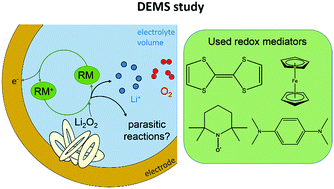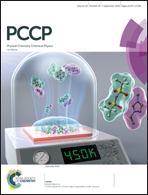A new thin layer cell for battery related DEMS-experiments: the activity of redox mediators in the Li–O2 cell†
Abstract
The reversibility of current Li–O2 batteries suffers from high charging overpotentials. To address this problem, the use of redox mediators has been proposed, which are supposed to improve the sluggish reaction kinetics of the oxygen evolution reaction via a solution mediated oxidation of lithium peroxide. In this study, we present a new thin layer cell for battery related differential electrochemical mass spectrometry (DEMS) experiments, which exhibits a high electrode surface area to electrolyte volume ratio which is closer to the situation in batteries other approaches/cells with their usually large electrolyte excess. The confined volume also allows a better distinction between the mediating activity of a redox system and a near continuous electrochemical reaction of this species. One further benefit of the new thin layer cell is that experiments can easily be performed under different O2-partial pressures. This new set-up allows the highly sensitive detection of volatile species formed during the OER. Therefore, small changes in the number of electrons transferred per oxygen molecule are observable. These changes help to identify side reactions and possible decomposition of the reaction products. During our experiments, we investigated the impact of TTF, TMPD, Fc and TEMPO on the oxidation of Li2O2. Within our experiments, we are able to precisely determine the potential at which the catalytic activity of the redox mediation starts. A comparison between the potential at which we observe the activity of the redox mediator to the half wave potential of the redox system could be explained with an outer sphere electron transfer for the oxidation of Li2O2 by a redox mediator. This observation is confirmed by a theoretical treatment of the redox mediation mechanism. Moreover, insights into the number of transferred electrons per oxygen molecule during the activity of the different redox mediators reveal the presence of side reactions. This finding is also underlined by an unexpected shift of the CO2 evolution onset for the redox mediator containing electrolytes. Our experiments also reveal that a Li–O2 cell, which contains a redox mediator, undergoes less fluctuation in its reversibility compared to a cell without a redox mediator.



 Please wait while we load your content...
Please wait while we load your content...